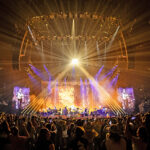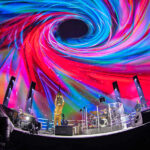
Multi-Platinum-selling country star Sam Hunt recently wrapped up his Summer on the Outskirts Tour, which ran from the beginning of July through early September. The tour featured a production design by Darien Koop of Design DarKo and a lighting design by Bobby Grey of Notan Creative. The two of them told PLSN that the collaborative design for this tour all started with a bridge.
Longtime friends Koop and Grey were brought in to pitch designs to Hunt’s Production Manager, Nate Smith. Koop had done some initial research and ended up drawing an older bridge as the center focal point of the stage design. That element sealed the deal, so to speak. “A big part of the design was Sam’s desire to go back to his roots,” says Koop, “so, I did research into his past, his history, and where he came from—Cedarville, GA. That, in combination with his latest singles, ‘Water Under the Bridge’ and ‘Outskirts,’ all worked together. I came up with a couple of different ideas that we bounced around until we just landed on the concept of the bridge.”
Once the direction of the bridge was chosen, Koop started drawing it and putting together the set; adding in the staging and the video ramp. “Envisioning this idea of the bridge, I then was really able to set a scene with everything,” Koop comments. “When everything came together, it all ended up being complementary shapes to that bridge. The other pieces also let us build several different scenes throughout the show. For example, we were able to have the song ‘House Party’ where there’s a house on the upstage video wall, and the bridge is completely gone. It’s flown up and out, but then the video ramps are the grass and front yard of the house. Later, the bridge can come on and he gets on it.” Add content ‘water’ and you’re ready to go for “Water Under the Bridge.”
Grey knew immediately that the bridge was the way to go. “Once Darien sent the drawing of the bridge, there was no doubt looking at it. It immediately hit exactly what they were looking for with the design of the show. Sam looked at the bridge drawing and said ‘I want that. I want to sing up on the bridge.’” Koop agrees, saying “It just hit right. ‘Water Under the Bridge’ and ‘Outskirts’, which were absolute standouts for the production design and bringing the whole thing together. But the design worked for the whole show just as well.”
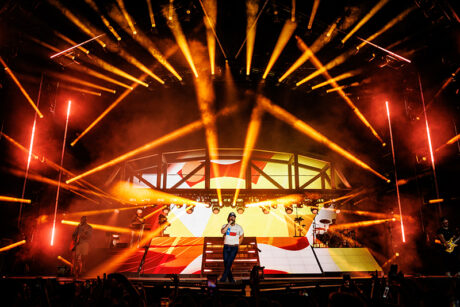
Flying Bridge
Gallagher Staging in Nashville fabricated the bridge, and it was automated by Atlanta Rigging Systems (ARS). The two companies worked closely together to make sure everything was built to fly. “What was great about the bridge fabrication were the actual bridge portions above the decking,” notes Koop. “Gallagher—and James McKinney—knocked out the bridge so well. I still owe that guy a bottle of whiskey.” Grey concurs with Koop’s opinion on the bridge structure. “They did better on that bridge than we could have fathomed, it looked great and worked so well.”
The bottom of the bridge is made up of Tyler Truss GT Truss, and Tyler worked directly with the whole team to be able to organize the engineering. “The rest was regular Gallagher decks on top of that GT Truss, which was perfect, because the GT Truss was 50’ wide and the stage decks were 48’ wide, leaving a foot of overhang on either side for pick points,” Koop explains. “Then each one of the actual uprights on the bridge is where we hid chains for the motors. We scenically blended all the motors into positions so that it really made sense. When we brought in ARS, they were able to run with it. They fully dove in making sure it automated the right way; could move at the right speeds; and most importantly, made sure it was safe. ARS also fabricated custom pieces for the GT Truss to be able to do all the torm dropdowns, making those nice and sturdy; to be able to make the builds solid every day.” A Kinesys automation system was used to automate the bridge on this tour.
The designers came up with some solutions that also made the bridge do double duty for the show. The bridge structure starts out the show fully flown up to the grid and the Tyler GT Truss structure has a lot of Grey’s lights mounted to it. To the audience, it looks like a standard truss rig hung with lights. When the show opens the audience sees the video ramps, made with ROE Visual Black Marble panels, and the big [50’ x 34’] LED video wall upstage consisting of ROE Visual Vanish 8T, and some scenic arches. There are two upstage trusses that are used through the first four songs. “Then the bridge reveals itself and comes down so that Sam could walk up the center and get on it,” explains Koop. “He rides it up and down for a song. Gallagher and ARS came up with an awesome custom safety system for Sam, with several custom belts made for him in his style that could hold him. They put a 24’ cable on the bridge deck that he could clip a six-foot lanyard onto, so he had a big range of motion on the bridge. The bridge had five positions including a mid-position, so the bridge was in the middle of the scene and still let us use the lights on it. It could be moved to different levels throughout the show.”
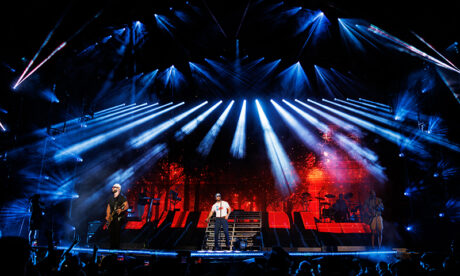
Creative Content
Hunt is a fan of old Field and Stream magazines and its period, hand-drawn artwork, “so the video content really shifted in that aesthetic direction,” says Koop. The video content was created by FragmentNine [F9], which both Grey and Koop have worked for, and with, over the years. “We have a longstanding relationship and friendship with them,” comments Koop. “They’re designers themselves, so a big thing that they bring to a project is that they understand the artistry and creative of putting a show together, versus just making a piece of content. The song, ‘Ex to See’ is the second to last song of the night, and one that’s very important to Sam. We all wanted it to be big, and impactful. We wanted to get away from previous iterations of what that song looked like. We threw everything at it, production-wise—it’s the most amount of bridge moves; it’s the most of everything. FragmentNine came up with motion tracking elements to be able to take layers and track with the bridge as it moved, to be able to do some backlight and strobing effects with the video. That really was a gamechanger for that song.”
The video package and crew were provided by the Fuse Technical Group. They worked closely with the production team to create a flexible solution for the B-stage camera since the B-stage was different depending on the venue. “One of the great things about Fuse is that they understand video and the basis of what you’re trying to accomplish, and they do it well,” Koop says. “Everything from the video products, to getting the right camera package together, to supplying an excellent video director and video crew. For the B-stage, we needed to cost effectively be able to have a camera out there because it was going to change every single day based off different venues. Fuse ran a single leash out there, so that in the last minute of the song before Sam went out there, they would disconnect the pit handheld cam. The camera op would run out, plug in, and then be there to catch Sam when he got there. Then we had a robo cam also at the B-stage to be able to catch a second angle, which was really solid.”
Hunt owns his own media servers—PRG Mboxes—so there was a bit of intake with that to be able to make sure that everything worked. Koop explains, “Mike Marcario, the touring LD, is a solid, solid programmer and really jumped in to handle the media server programming as well and made sure that all that went seamlessly.”
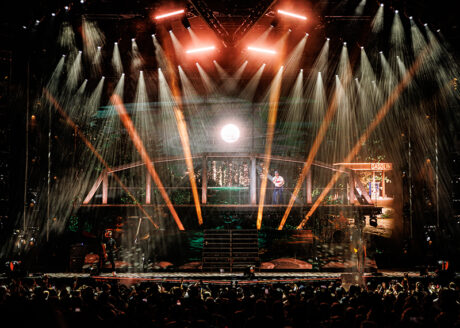
A Story Using Color & Light
When it came time to layer lighting and video together, the designers worked together with the F9 team on developing a cohesive color story. Grey explains, “Darien and I were thrilled to bring in our friends at FragmentNine to create new content. We also were able to adapt some of the existing tour content and freshen it up a little bit. In laying out the color story and content plan, we utilized the video surfaces, set and lighting rig to play together to set scenes and environments. For example, for ‘Water Under the Bridge’, F9 put together this great perspective video that gave us a rushing river with rapids falling down the video ramps. For the more up-tempo songs with a lot of distorting guitars, we drove more into the reds and warmer colors with static, digital noise and abstract shapes. There were some songs based around vintage content, like home movies of Sam that had been adapted to tour content, those had a CTO and gray steel feel to it. A lot of the content color, and a lot of the lighting color was more driven by the color story that we were trying to tell along with the music.”
Hunt’s catalog is very diverse. His songs don’t sound the same; he’s got some pop songs, some that lean towards rock, and others that lean towards country. “We really wanted to keep it looking fresh throughout the show and give it an arc; to tell a story,” says Grey. “Lighting-wise, I wanted to just create architecture as much as possible but make it so that we weren’t just looking at the same thing all the time. So, I lined all the arches, legs, and the V-trusses coming downstage with linear LED from ACME Pixel Lines. Having linear LED on there, in full pixel mode, let us break it up. When we wanted to see the shape of the stage, we could bring the outline of the stage on, or we could break it up and do pixels. There were times where we did gradients on the legs and trusses. There were times where we could push everything to full and make it blinding and bright. Then there are times where we could do really delicate moments and bring little moments of music out or shift one direction to the other. We were able to just really paint a lot of pictures with all the linear lighting. And, of course, the diversity of being able to bring the bridge in and out, helped change up the looks.”
Another design element that helped with the range of looks was having the large video surface upstage as a backdrop. “We were able to play with bringing the perspective of the virtual world into the real world,” describes Grey. “We were able to either treat it like traditional video and have 2D visuals, cool stuff, and I-Mag going on the screens. Or play on perspective and continue the scene upstage going up the ramps and off into a vanishing point in the video wall. So, keeping it fresh was not difficult. It was definitely a goal. Of course, we also had Robe MegaPointes, and a Robe Forte RoboSpot for his back spot, and ACME Lyras, really big profile fixtures, from upstage. We were able to build around a fixture type, build around a look in every song, and create a bespoke feeling for every song.”
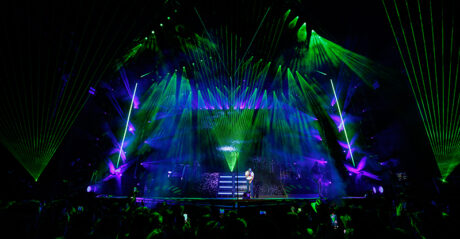
Key Lighting Gear Choices
As a part of Grey’s lighting design, he lined the entire bottom of the bridge with Robe MegaPointes. “We had a really tight line of MegaPointes as close together as we could,” he explains. “When the show starts with the bridge up, it just looks like a traditional pre-rigged truss full of lights. For the first couple of songs, they are just used in a traditional way. Then we had this great reveal moment where we bring the bridge in. For our fixture choice, to augment this architecture that we’d created, we had X4 Bar 20s from GLP all along the front that were able to go straight out and give us a nice clean line of LED when the bridge was out. When the bridge came in, we would tip them back up to uplight the front of the bridge.”
The lighting gear and crew were supplied by Upstaging for this tour. “Matt [Pirich] and the Upstaging team were fantastic,” says Grey. “They engineered a custom bracket solution for us, so that we were able to have the torms, the legs on the side, meet the horizontal trusses over the stage. Of course, Robe and GLP always take really good care of us. As I said, we had RoboSpots on the gig, with a RoboSpot back spot for Sam, which was a huge part of giving him that big look and making the show all about him. I loved that look of him walking around, and there being this bright cone of light from a [Robe] Forte following him around. Honestly, all of Upstaging’s inventory was great, and their crew were great. All their guys worked so hard to get it built, and Upstaging took good care of us.”
For the variability of the B-stage, Grey went with wireless, battery-powered Astera Titan Tubes. “We wanted to have a simple solution for the B-stage, so we went with Titan Tubes,” Grey comments. “We didn’t want to overdo that area. That needed to be a very intimate moment with Sam. Darien worked with Upstaging to be able to come up with a custom-fabricated piece for the Titan Tubes out there. Generally, there were 12, but for some venues, they fabricated us some single upright stands in case there were sightline issues and things like that.”
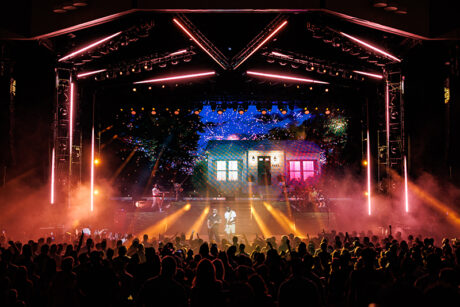
Lasers and Effects
For the Sam Hunt tour, the team also deployed lasers with their design. Lasers aren’t something that’s normally seen with country artists, but then Hunt is not your average country act. “Sam has had lasers on his shows in the past,” explains Koop, “but a lot of time in country music, lasers seem to be a kind of ‘addition’ and not a really well thought through creative element. Yes, lasers look cool when they’re on, but having them function with the show is a whole other thing. We worked with Paige [Newman] of Image Engineering/Image SFX. I went down to their shop in Vegas to meet with them and go through the different options. I settled on getting four audience scanners and three 30W lasers. We determined the best positions and the best ways to utilize them inside of the rig. I called on an old friend of mine, Vinny Forti, who works with lasers in a lot of different facets. One of the things he was able to bring in was just a specific musicality to the programming that really set it apart.”
When it came to fog and haze, Koop and Grey went with products from the Chicago-based Master FX that Upstaging supplied as a part of its package. “We had eight of the Mystic 2 hazers [Advanced Haze Generators] piled around the stage,” Koop says, “and they did a good job.” Grey also called out the fog machines with LED lighting that was used on the underside of the bridge for effects. “We used seven of Master FXs Atlas foggers [Advanced LED Fog Generators] mounted upside down on the bottom of the bridge shooting down. They are bright and have a lot of output. As the bridge came down, it gave us a couple of different looks and the high-density fluid doesn’t stick around for long. The LED lighting paired with the cryo plume effect worked so well. You’d see the smoke coming out from the bottom of it and flowing through the set. The Atlas created these really cool scenes of mist flowing with the colored lighting. We worked with the Master FX team, and Upstaging, to get the right fluid to use in terms of how fast the fog/haze would dissipate; both Master FX and Upstaging were supportive of what we were trying to do.”
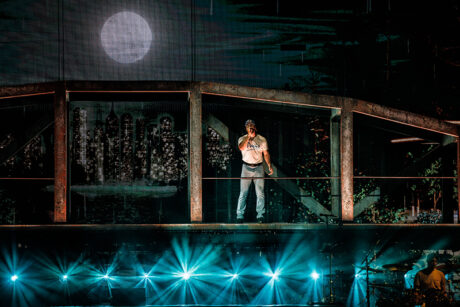
Bringing it All Together
Putting the show together in rehearsals, Koop and Grey, along with Laser Programmer Forti and Touring Lighting Director Marcario all figured out the ways to specifically delineate moments, so that lasers had a chance to stand out, or lighting do its thing. “The intro was one of the most fun organic pieces of the show,” states Koop. “The whole thing manifested itself in like 20 minutes. The intro was this massively epic beautiful thing because everyone on the creative team was in sync. We were able to put that intro together the first try out of the gate. Everyone just went, ‘That’s it. That’s the most epic intro we’ve ever had.’ It’s when you have that right creative team, and everybody’s firing on the same page, it was really exciting.”
As noted, the creative and production team gelled really well on this tour. For Grey, who programmed his design along with Lighting Director Marcario, felt it was “such a welcoming environment. Mike Marcario came in as a recommendation from [PM] Nate Smith. Mike spent a week in my studio previzing with me and he immediately just latched onto our workflow, figured out exactly what his role was, and exceeded his role. While I was working on programming the show, he was behind us cracking into the media servers, and retroactively going back and figuring out what had been done before. He was invaluable to getting the Mbox media servers figured out for us, because neither Darian nor I are Mbox experts. So, Mike took ownership of it really, really quickly. Then during the show, what I liked was that Mike was carefully taking spotlight key light notes. We didn’t have to worry about it; he took worrying about key light completely off our plate and made sure that people got lit at the right time. He was careful to look at manual triggers when he needed to fade things out. He set up inhibitives for every fixture type, and was exposing them for camera, as we were shooting I-Mag. He was just really on top of everything.” Koop agrees on Marcario’s contributions to the show. “You don’t always have to light an artist perfectly even; you can have those theatrical moments,” he points out, “and really bring in solid sidelight. It was different things that, like Bobby said, Mike just nailed; he just got it and understood what we wanted.”
Bringing the team together fell to Nate Smith as the Production Manager. “Nate is the reason we were on the job, he brought us in,” says Grey. “Nate is the most pragmatic and reasonable production manager that we’ve ever dealt with. There was never a moment where Nate came to us with something that was a problem that he couldn’t then say, ‘Now here’s what I think the solution is.’ He would immediately work out an answer. He’s willing to be challenged; thrilled in fact. So, if we came to him and said, ‘Man, we really want to do this, but it’s going to be difficult.’ He’s okay with it not being the easiest answer for everybody if it’s right for the show.”
From Koop’s point of view, the whole process went well on this Sam Hunt tour. “We get to work with a lot of different artists, a lot of different people, in a lot of different circumstances,” he says. “I think that, for me, the thing that was special was there really wasn’t a negative aspect to this project. There wasn’t a thing that we walked away feeling bummed about. Nate, the Production Manager, is one of the most straightforward and honest, but also legitimately caring people and production managers I’ve ever worked with. Also, the crew was great. Nate’s got a really good talent for pulling together a solid group of people. If I could work with him on every project I would because he is a special person and deserves every bit of recognition he could get.”
Clearly, Koop and Grey enjoyed working on the Summer on the Outskirts Tour with Sam Hunt and the band, mostly because Hunt, like the designers, really wants to keep raising the bar to another level show for his fans. “When I got to meet and sit down with Sam, from the get-go, he was just involved and really cared,” recalls Koop. “And the band, across the board, everyone was able to say, ‘okay, how do we make this better?’ They’re on their 10th year touring so they have a feel for what they’re doing and what they want to do. And what they want to do is always be finding the next step to make it better.”
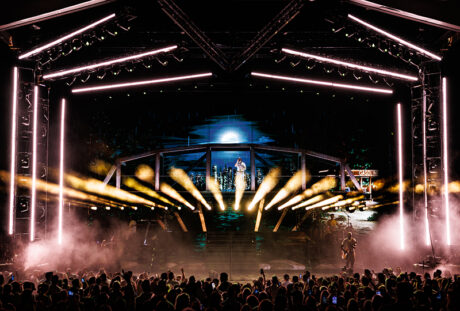
PRODUCTION TEAM
- Production Manager: Nate Smith
- Production and Set Designers: Darien Koop, Design DarKo
- Lighting Designer/ Programming: Bobby Grey, Notan Creative
- Touring LD/ Media Server Programmer: Mike Marcario
- Laser Programmer: Vinny Forti
- Content Creators: FragmentNine, Jeremy Lechterman and Ally Munro / Andy Reuter / Stevan Alan
- Lighting Crew Chief: Troy Smith
- Lighting Techs: John (TuTone) Sumitra, Andrew Heid, Chris Griffin, Erin Grace
- Video Crew Chief: Jamey Malcolm
- Video Director: Matt Binford
- Video Engineer: Jason Baker
- LED Tech: Keaton Benjamin
- Overlay Rigger: Morgan Prine
- Tour Rigger: Wayne Parmley
- Automation: Dylan Keretz
- Automation Programming: Dan Martell
- Set Carps: Dave Maher, Chayse Long
- Laser Tech: Luke Eisner
- Stage Manager: Brandon Leedham
- Production Coordinator: Stephanie Navarro
- Production Assistant: Helena Jeen
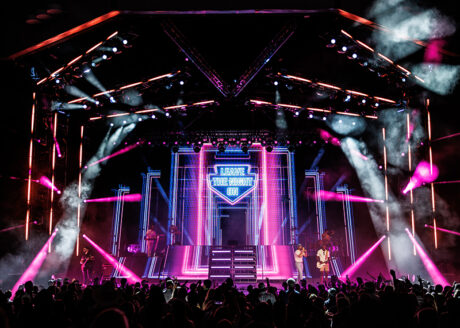
VENDORS
- Lighting: Upstaging, John Huddleston and Matt Gohring
- Video: Fuse Technical Group, Mike Pirich and Quinn Adamson
- Content: FragmentNine, Jeremy Lechterman
- Staging: Gallagher Staging Nashville, Tye Trussel and James McKinney
- Rigging: Atlanta Rigging Systems, Jon Wismer
- Lasers: Image Engineering/ImageSFX, Paige Newman
- Trucking: Stage Call, Adam Shick

